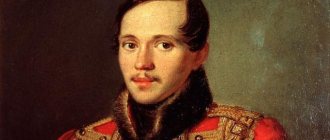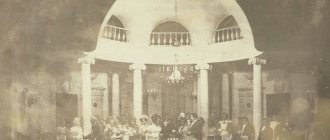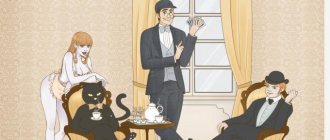- Essays
- On literature
- Other
- Russian literature of the 20th century (9th grade)
The beginning of the twentieth century in Russian literature is the brightness of the “Silver Age” in the entire cultural heritage. Critical sentiments gave rise to literary masterpieces and discovered new names. Time for realists with a critical eye. Art Nouveau began to actively develop. Writers and poets of that time penetrated deeply not only into the minds, but also into human souls. It was a difficult time. Capitalism, revolutionary views, along with philosophical and religious theories, were reflected in literature.
This is the heyday of poetry. Poetic trends are different, but modernist views predominate. This is a period of time when foundations, ideals, and values are revised.
The chronology in the literary life of the twentieth century can be traced as follows: 1892 - 1917, the end of timelessness (the revolutionary rise of society, the manifesto and collection “Symbols”, the work of Maxim Gorky). Although, perhaps the end of this period falls on 1921-1922. The time of emigrants, exiled writers, philosophers and historians. Russian literature of the 20th century is usually divided into: realism, modernism, literary avant-garde.
M. Gorky and L.N. Andreev played an important role in the literary movement of that time. After the revolution, Russia began a difficult period. It is hard to bear not only for the people who had to live after the revolution, but also for the literary elite it is almost catastrophic. Many writers were forced to leave their homeland. Some were expelled, while others emigrated of their own free will. But creative and literary life in Russia does not stop. Difficult times reveal new talents. Bright young writers with a fresh look and sharp words, participants in the Civil War: L. Leonov, M. Sholokhov, A. Fadeev. They have a style and look that is not like the classics. But they are interesting, in demand, and close to the people.
The thirties are characterized in literature as “the years of the great turning point.” The old foundations are crumbling. The party actively controls the literary environment. P. Florensky, A. Losev, A. Voronsky, and D. Kharms were arrested. The repressed intelligentsia perishes. But the basis of the intelligentsia is precisely cultural figures. The result of the repressions of the thirties was the death of a large number of writers, including: N. Klyuev, O. Mandelstam, I. Kataev, I. Babel, B. Pilnyak, P. Vasiliev, A. Voronsky, B. Kornilov. There are practically no opportunities for the development of literature. Everything is contested, condemned, and subjected to total scrutiny.
But this time gives us such talented people as: V.V. Mayakovsky, S.A. Yesenin, A.A. Akhmatova, A.N. Tolstoy, E.I. Zamyatin, M.M. Zoshchenko, M.A. Sholokhov, M.A. Bulgakov, A.P. Platonov, O.E. Mandelstam, M.I. Tsvetaeva. Today it is impossible to imagine literature and poetry without these names. And their lives at that time were constantly in danger. The works might never have been published. We wouldn’t recognize Tsvetaeva’s touching poems, wouldn’t hear Mayakovsky’s rhythm, wouldn’t laugh at Zoshchensky’s stories, wouldn’t confess our love with Yesenin’s poems, and wouldn’t reflect on Bulgakov’s mysterious style.
The period of the twentieth century in Russian literature is marked by the phenomenon of crisis. A crisis of souls, a crisis of the mind, a crisis of feelings. But reading works written by writers and poets of that time, you clearly understand that talent is a gift that cannot be defeated. He, like a sprout, will break through the asphalt and will reach for the sun, reach for life. And the path will not be easy, but life itself will put everything in its place. There is a place on the bookshelf of every home for books by poets and prose writers of the twentieth century.
Other works: ← Features of Russian literature of the 19th century ↑ Other Features of the depiction of heroes of Russian literature of the 19th century →
Essay on the topic: The theme of the intelligentsia and revolution in Russian literature of the 20th century
Composition. The theme of the intelligentsia and revolution in Russian literature of the 20th century
The theme of “Intellectuals and Revolution” is an important theme in the works of writers of Russian literature of the 20th century. Representatives of the intelligentsia were faced with the acute question of choosing the ideals of kindness and compassion, the principles of spirituality, humanism, as the highest criteria of human compassion. In the works of B.A. Lavrenev’s “The Forty-First” and A.N. Tolstoy’s “The Viper,” the authors reveal the unusual nature of the Civil War era itself, which abruptly turned the fate of entire generations and class classes, including the intelligentsia, in particular Lieutenant Vadim Nikolaevich, in the story “The Forty-First,” and the daughter of the merchant of the second guild Olga Vyacheslavovna in the story “Viper.” Two different writers expose the destructive power of destruction, bitterness, and inhumanity that accompany the fall of the old world. The story of the heroes demonstrates the incompatibility of war and violence with human happiness, human nature itself. These works reveal the time of great historical trials that confronted the intelligentsia with the life drama of the historical development of Russia. In the story “The Viper,” a girl from an intelligent family goes to war, overwhelmed by hatred and revenge for her ruined family. Having gone through all the hardships and deprivations of a senseless, cruel war, where she had to kill and lose her loved one, Zotova turns from a pretty young girl into a “demobilized soldier; Well, is this a woman?” The natural world, people in its cycle, simple human relationships - these are the highest values for these writers. The flow of history, bursting into established existence, the destructive events of war and revolution - all this is naturally incompatible with human life, with human happiness. In B. Lavrenev’s story “The Forty-First,” the guard’s second lieutenant Govorukho-Otrok is shown, whom the cruel war did not break. He always behaved with the dignity characteristic of a military man from an intelligent family. And even when the Red Army soldiers, together with a second lieutenant, “climbed” the dunes, the Red Army soldiers walked “stumbling, swaying from the wind,” one lieutenant walked straight, calmly. When Evsyukov asked him, “Are you two-core or something?”, he replied: “You won’t understand. Difference of cultures. Your body suppresses the spirit, but my spirit controls the body. I can tell myself not to suffer.” The author's narratives in these works are colored by a feeling of catastrophe - inevitable and inexplicable for the intelligentsia, which was unsettled by the revolution and, as it were, undergoing a test of authenticity, a test. Both works end dramatically and, as it were, for the intelligentsia in particular, convey the drama of human existence, shaken and destroyed under the pressure of war and revolution. The authors reveal the suffering, doubts, anxiety, and drama of the intelligentsia associated with a sharp turning point in history, with a brutal revolutionary shake-up, and at the same time shows the senseless nightmare of war for human life.
novstudent.ru | 10/26/2012
silver Age
Speaking about poets of the 20th century, it is impossible not to mention such a literary phenomenon as the Silver Age. This is a period in the history of Russian literature, spanning the late 19th and early 20th centuries.
At the turn of the century, many poets and many literary movements appeared in Russia.
The trends of the Silver Age include symbolism, imagism, acmeism, and futurism.
Rice. 1. Silver Age.
A. A. Blok, V. Ya. Bryusov, A. Bely, K. D. Balmont, D. S. Merezhkovsky, I. F. Annensky, F. Sologub, V. Ivanov, Z. Gippius worked within the framework of symbolism.
The most famous acmeists are considered to be A. A. Akhmatova, N. S. Gumilyov, O. E. Mandelstam. S. M. Gorodetsky, M. A. Zenkevich, V. I. Narbut, G. Ivanov also worked within this direction.
A prominent representative of futurism is V.V. Mayakovsky. Other poets also worked in this direction: V.V. Khlebnikov, B.L. Pasternak, D.D. Burlyuk, V.V. Kamensky, A.E. Kruchenykh, I. Severyanin, V.G. Shershenevich, S. M. Tretyakov.
Imagism includes S. A. Yesenin (his early work), A. B. Mariengof.
Essay: Poetry of the Silver Age
(357 words) The Silver Age of Russian literature is a catchphrase that refers to the period of Russian literature of the late 19th - early 20th centuries. The origin of the Silver Age is characterized by the emergence of symbolism, and its completion is considered to be 1921 - the death of A. Blok, the most famous symbolist poet.
The literature of the Silver Age is characterized by such directions of modernism as: symbolism, acmeism and futurism. The key thematic features of this period are: spiritual crisis, internal chaos, disharmony and mysticism. Thus, the symbolists are considered to be the founders of a new direction in literature, who, in turn, declared “war” on the materialistic worldview; they believed that poets were endowed with the ability to join the transcendental world with the help of symbols of art. Initially, symbolism took the form of decadence. This is a direction in literature, expressed by decadence and pronounced individualism. Decadence was clearly expressed in the early works of A. Blok and A. Bely. Symbolists separated the concepts of “society” and “personality”, equating them. In the person himself, they focused on the beauty and diversity of his inner world, and his feelings became the basis of their creativity.
The opponents of the Symbolists were the Acmeists (N. Gumilyov and Anna Akhmatova); they denied the mystical aspirations of the Symbolists, proclaiming the value of real life. Acmeists called for giving words their original meaning, freeing them from symbolic interpretations. The main criterion for assessing creativity was impeccable aesthetic taste and beauty of words. They did not focus their attention on the search for the meaning of life and religious signs; the Acmeists saw the world as flawless and portrayed it exactly like that in their work.
In the 1910s of the 20th century, along with Acmeism, another literary movement was revived - futurism. With its advent, collectivism prevailed over personal development and individualism. The futurists (the hooligan poets familiar to many - Vladimir Mayakovsky and Alexei Kruchenykh) did not perceive man as a target for study, they did not see the point in separating him from society, which completely contradicted the position of the symbolists. The objects of observation for futurists were: cars, airplanes, machine tools and other discoveries of scientific and technological progress of that time. The futurists intended to build a “new culture” without immersion in moral principles.
There are many other movements of the Silver Age, including many other poets of the time. Thus, the well-known and beloved poet Sergei Yesenin belongs to the “new peasant” poets, who are characterized by an appeal to the theme of rural Russia, and Anatoly Mariengof is considered the founder of imagism, where the goal of creativity is to create an image. Although the cult of life-creation of the Silver Age poets played an important role in the development of Russian culture, it had very disastrous consequences in the lives of many creators.
Author: Polina Chernyshova



